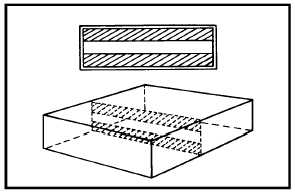5
Figure 1B.—Waveguide iris.
IN ANSWERING QUESTION 1-37, REFER
TO FIGURE 1B.
1-37. The iris shown in the figure has what
type of equivalent circuit?
1. Parallel-LC
2. Shunt-resistive
3. Shunt-inductive
4. Shunt-capacitive
1-38. A waveguide iris that covers part of both
the electric and magnetic planes acts as
what type of equivalent circuit at the
resonant frequency?
1. As a shunt inductive reactance
2. As a shunt resistance
3. As a shunt capacitive reactance
4. Each of the above
1-39. A horn can be used as a waveguide
termination device because it provides
which of the following electrical
functions?
1. A reflective load
2. An absorptive load
3. An abrupt change in impedance
4. A gradual change in impedance
1-40. For a waveguide to be terminated with a
resistive load, that load must be matched
to which of the following properties of
the waveguide?
1. The bandwidth
2. The frequency
3. The inductance
4. The characteristic impedance
1-41. A resistive device with the sole purpose
of absorbing all the energy in a
waveguide without causing reflections is
a/an
1. iris
2. horn
3. antenna
4. dummy load
1-42. A resistive load most often dissipates
energy in which of the following forms?
1. Heat
2. Light
3. Magnetic
4. Electrical
1-43. Reflections will be caused by an abrupt
change in which of the following
waveguide physical characteristics?
1. Size
2. Shape
3. Dielectric material
4. Each of the above
1-44. A waveguide bend which is in the E or H
plane must be greater than two
wavelengths to prevent
1. cracking
2. reflections
3. energy gaps
4. electrolysis

